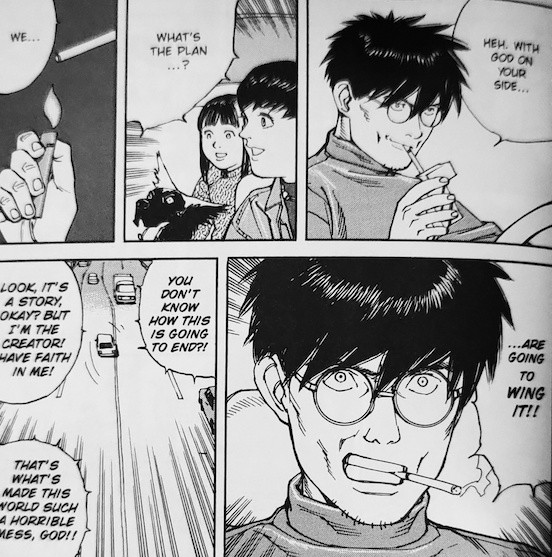The late Satoshi Kon had plumbed the depths of the nature of identity like no other artist. His anime, ‘Perfect Blue’, is one of the most dizzying and intelligent explorations of mental instability and how it affects the idea of the self. ‘Tokyo Godfathers’, another of his gems, is a more light-hearted, but very profound, take on what are the definitions of parenthood.
In his 1995–96 manga ‘Opus’ he tackled the issue of identity, but no longer for our mortal plane. Instead, this one is about the identity of God!

God is an Artist
For theists among us it is hard to deny the beauty of God’s nature, by which I mean the nature he created around us. Concepts like paradise, jannat, the garden of Eden, all depict the beauty of creation, and the visual poetry of natural beauty.
Taken to the spiritual level there is beauty in emotions, in relations, in cycles of change, which are also attributed to the deft touch of the entity that has existed for eternity before us and will exist for an eternity after us. Such an entity will, doubtless, know how objects and events fit into each other much better than we can ever fathom.
So then God, as Kon depicts, is an artist. And this idea is there in many religions as well. Shiva is a primordial dancer, Jesus is a carpenter. Art and craft is at the very heart of Creation.
In Opus, the Manga artist Chikara Nagai discovers he has unknowingly created a world inside his comics where the characters were hitherto unaware of his presence but were living real lives. That Nagai is the one who is shaping their life’s journey, and even deciding when and how they die, puts him in the position of God for them.
But this is not a role he is good at.
What does it mean when the Creator themself is not aware that they have created life?
An Artist as Judge-Jury-Executioner
Nagai has never known the responsibility he took on when he became an artist because his work was only alive in his mind. Suddenly he is faced with the prospect of making life-or-death decisions for them. And, wouldn’t you know it, the villain of his manga is actually more powerful than him in that world.
However, this is not a God who smiles benevolently at them, nor is he one who is unmoved by the lives of his creations. Nagai is hysterical when faced with this alternate reality, vulnerable to the violence around him, and unable to devise quick solutions for his creations without throwing everything into turmoil.
When everyone looks to you for answers, and when people start questioning you for how you have chosen to direct their lives, suddenly the job of eternal Creator is not so alluring. A God that becomes visible is one that becomes answerable.
In the final, incomplete chapter, we are introduced to the fictional, within-the-manga version of Satoshi Kon who is the creator of Nagai and who is suddenly faced with his own creation come to life and throwing questions at him. Is it turtles all the way down?
We assume that God is an omnipotent being and that nothing cannot be resolved by him. But, what if his creation, humanity in this case, exists in a world of pain and suffering and danger beyond what God is prepared to face? The complex lives and minds of the creation have escaped the narrow boundaries set by the creator and have started demanding more and refusing to play by the rules? If God is just a creator and not omnipotent, then what is the difference between him and the rest of us?
All of Kon’s works throw big questions like this out at us. They cannot necessarily be answered, even by him. But, nevertheless, they serve to take us out of the mundane plane of existence that we are used to and transport us somewhere new. In that way he too played a kind of God role with his readers. And, come to think of it, years after his death he is still doing that. A creator who transcends death is perhaps closer to theCreator.
Being a God, and knowing how to play God, are not the same thing.